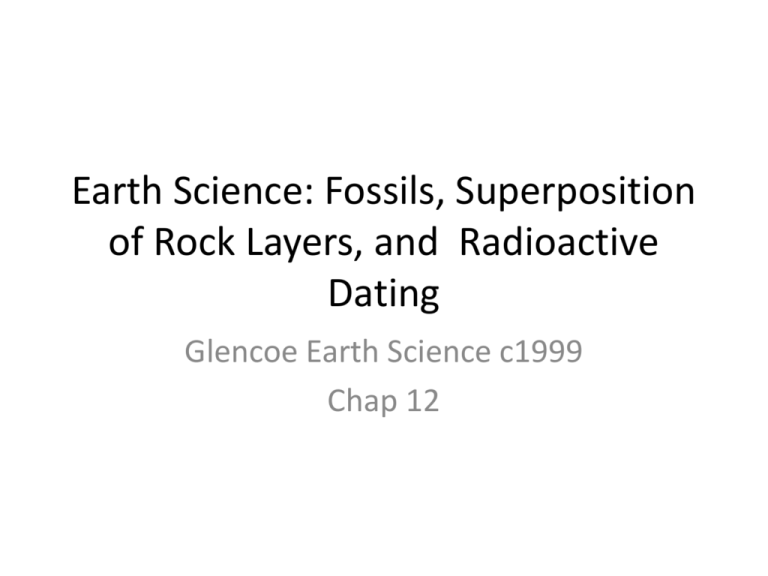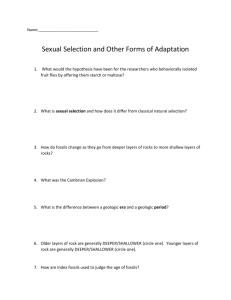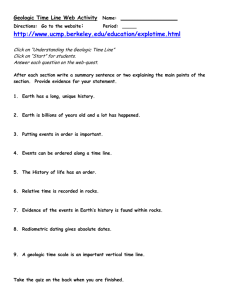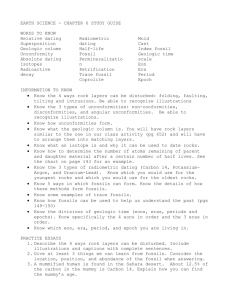Earth Science: Fossils, Superposition of Rock Layers, and
advertisement

Earth Science: Fossils, Superposition of Rock Layers, and Radioactive Dating Glencoe Earth Science c1999 Chap 12 Fossils—what are they • Fossils are the remains, imprints, or traces of once-living organisms Conditions Needed Fossilize • The dead organism must be protected from scavengers and microorganisms, so it must be buried quickly by sediment or something else. • Organisms are more likely to fossilize if they have hard parts like bones, shells, or teeth. • Fossils are usually found in sedimentary rocks (This is because the sediments that cover them become sedimentary rocks, and the heat and pressure needed to form igneous or metamorphic rocks often destroy fossils.) Types of Fossils 1. Petrified Remains: bones, wood, etc. • Hard and rock-like • Some or all of the original materials have been replaced by minerals • For example, water flowing over and through a bone may dissolve the calcium in the bone and replace it with quartz. (Scientific name for this?) Petrified Wood and Bones Petrified Wood Petrified Bones Types of Fossils (2) 2. • • • Carbonaceous Films—outlines of organisms Most tissues contain carbon Buried in sediment Over time, more sediment cause more pressure and heat on the dead tissue • This forces gases and liquids from the tissue, leaving an outline of the original organism Carbonaceous Film Types of Fossils (3) 3. Molds and Casts • Seashells or other hard parts fall into soft sediment, which eventually turns into rock. • Pores in the rock let water and air reach the shell, which then decays, leaving a void in the rock called a mold • The mold can be filled with other sediments which harden, creating a cast Casts Types of Fossils (4) 4. Original Remains • When the actual remains of an organism are found • Examples – Insect trapped in amber – Human frozen in glacier – Animal found in tar pit Fossils: Original Remains Insect trapped in amber Types of Fossils (5) 5. Trace Fossils • Fossilized tracks or other evidence of animal activity Trace Fossils Worm trace burrow Dinosaur Track Index Fossils • Index fossils are from species that – existed on Earth for a relatively short period of time – Were abudndant – Were widespread geographically • Used to help date rock layers Fossils and Ancient Environments • The types of fossils we find tells us about what the environment used to be like at that location • Examples: – Antarctica used to be tropical – Iowa was once covered by a warm, shallow, sea (limestone and brachiopods fossils) Brachiopod Fossils Relative Dating (not your cousin!) • Relative dating is determining which rocks are the oldest, then the next oldest, etc.—the order of age • Relative dating does NOT tell you the actual age of the rocks, only which rocks are younger or older Principle of Superposition • States that in an undisturbed layer of rock, the oldest rocks are on the bottom and the rock layers become younger going up. Unconformities • Unconformities are GAPS in the rock layers • Three types – Angular – Disconformities – Nonconformities Angular Unconformities • Rock layers are tilted by tectonic forces • The tilted layers are eroded • New rock layers form on top of the tilted layers Angular Unconformities Disconformities • Rock layers form • The top layer is eroded, and may disappear altogether • New rock layers form on top, leaving a gap in the record Disconformities Nonconformities • When two different rock types meet Summary: Types of Unconformities Absolute Dating • Used to determine the age, in years, of a rock or other object • Uses the idea of Radioactive Decay • All elements are determined by the number of protons in their nucleus • When the number of protons change, the element changes. Half-Lives • Example: Unstable isotope Uranium-238 eventually becomes Lead-206 by emitting protons and neutrons • The Half-Life of a radioactive isotope is the amount of time it takes for half of the atoms in the isotope to decay into a different element • The half life of Carbon-14 is 5730 years Radiometric Dating • The original element is called the parent • When it decays into another element, it is called a daughter • Radiometric Dating: measuring and comparing the amounts of parent to daughter elements Parent-Daughter Radioactivity Radiocarbon Dating • Carbon-14 is useful for dating fossils, bones, and wood up to 50,000 years old • Carbon-14 exists in the atmosphere, and we breathe it in. • When we die, we don’t take in any more Carbon-14, and the Carbon-14 decays into Nitrogen-14 gas. • The amount of Carbon-14 left in a sample can help determine its age Principle of Uniformitarianism • 1700’s—James Hutton (Scotland) and Charles Lyell (England) • Uniformitarianism: Earth processes occurring today are similar to those that occurred in the past. • He observed that rocks form very slowly now, so he concluded that rocks have always formed very slowly Catastrophism • Is the opposite of Uniformitarianism • States that large catastrophes can quickly influence how land is shaped and when organisms become extinct. • Example: – Mt. St. Helens, Washington









